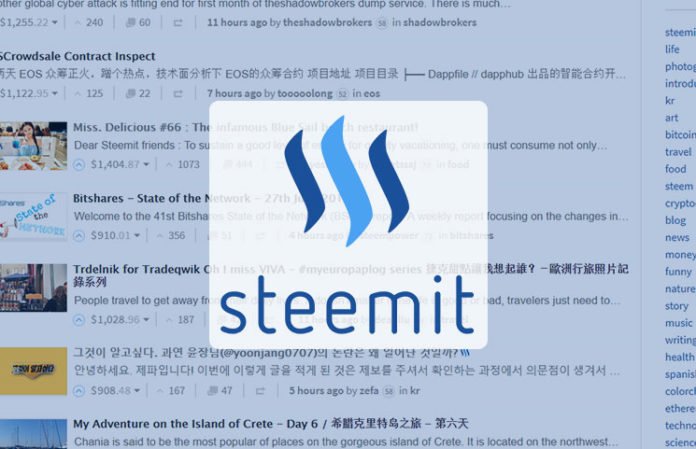What Is Steemit?
Steemit is a blockchain project that launched in March 2016. As of May 2017, the website had about 170,000 accounts.
With Steemit, users receive financial rewards in the form of STEEM and Steem Dollars in exchange for creating and curating content. It’s kind of like Reddit and other social media platforms, but users can earn legitimate rewards for their work.
The project was founded by Ned Scott and Dan Larimer, creator of BitShares. The two co-founders created the Steemit Inc. company in 2016.
How Does Steemit Work?
Steemit is based on a concept similar to Reddit. The website features a wide range of content and its main page, and users can upvote or downvote that content based on the perceived value of that content.
What makes Steemit different is that the text content is saved in a blockchain. Using a blockchain allows Steemit to reward comments and posts with secure tokens and value. Steemit has two different digital tokens, including STEEM and Steem Dollars. STEEM is a cryptocurrency token, while Steem Dollars are pegged to the US dollar.
Steemit can also host images. Users can upload images and other multimedia content.
To format posts, Steemit uses a WYSIWYG editor, although users can also choose to use Markdown formatting with HTML elements.
As with Reddit, Steemit users can upvote posts and comments. Authors who get upvoted can receive monetary rewards in the form of STEEM or Steem Dollars. Users are also rewarded for curating popular content. Curating content involves voting on comments and post submissions. The more STEEM Power a voter holds, the more vote strength they have.
One final Steemit feature is the reputation system. New Steemit accounts start with a reputation of 25. As an account receives positive or negative votes, that reputation moves up or down. This incentivizes online etiquette.
The Steemit Blockchain
Steemit runs on a blockchain named Steem. Steem’s blockchain is designed to transfer tokens in a frictionless way while also hosting text and multimedia.
Apps can also be built upon the Steem blockchain. Applications and websites can connect to the Steem blockchain. Because of its open and permissionless nature, it’s easy for third party apps and websites to build on the Steem blockchain. We’ve already seen a number of third parties do this.
There’s an Instagram-like app that transforms Steemit into a more Instagram-styled interface. There’s also Busy.org, a Steem-interacting website that uses an alternative UI. Finally, eSteem is an Android and iOS app for Steemit.
One of the unique features of the Steem blockchain is that it doesn’t use cryptographic hashes as addresses – like many blockchains use. Instead, users choose their own alphanumeric account names. That makes the accounts human-readable and easier to understand.
Another unique feature of the Steem blockchain is its use of a delegated proof of stake consensus mechanism, where block-creating accounts called “witnesses” are elected by Steem stakeholders. Instead of relying on proof of work to find blocks, the Steem network actively schedules these accounts to improve the time between blocks to three seconds.
Meanwhile, block producers receive a small portion of the rewards created in each block, with the rest being paid to authors and curators.
In terms of transaction fees, Steemit has no transaction costs for rate limiting or to pay its block producers. Instead, accounts use something called bandwidth. Bandwidth replenishes quickly – so fast that a typical user is neither affected nor limited.
Steemit Digital Tokens
There are two digital tokens for Steemit, including STEEM and Steem Dollars. You manage these tokens through your Steemit wallet, which is hosted on Steemit.com.
STEEM
STEEM is Steemit’s base token. The token is currently available on multiple cryptocurrency exchanges. The market value of STEEM determines the value of the pool of rewards paid by Steemit. The value of STEEM is also connected to the value of Steem Dollars.
One of the unique parts about the STEEM token is that it was launched with a highly-inflationary supply model that doubled every year. However, that changed as community demand increased. In December 2016, the inflation rate of Steem was dropped all the way down to 9.5% per year, with that inflation rate dropping by an additional 0.5% every year.
Steem Dollars
The Steem Dollar, or SBD, is a digital token pegged to the US dollar. You can trade Steem Dollars at cryptocurrency exchanges, or use them to buy goods and services online. You can also trade Steem Dollars for STEEM (and vice versa) using the internal marketplace on Steemit.
Steem Dollars are an interest-generating asset. When you hold Steem Dollars, you’ll receive an interest rate. As of March 2017, the interest rate is set at 2% per year. That interest rate may rise if the value of Steem Dollars drops below the value of the US Dollar. It’s kind of like Steemit’s built-in monetary policy mechanism.
The Steemit Wallet
You control the digital tokens above from your Steemit wallet. The web-based wallet lets you easily transfer Steem Dollars and STEEM. Additionally, the wallet lets you transfer tokens to and from interest-generating accounts. If you deposit your cryptocurrency into a savings account, it will take three days to withdraw.
Steemit Conclusion
Ultimately, Steemit is a unique social media website that rewards content curators and content posters. It uses a reputation system, a cryptocurrency system, and a built-in marketplace to promote good content. It’s like Reddit – but with rewards for people who post good content or contribute to curation tasks.
Steemit has gathered a lot of momentum since 2016, and Steemit’s cryptocurrencies have a surprisingly large market cap. With over 170,000 users at last count, Steemit is quickly becoming the next social media giant.
Hi! I am a robot. I just upvoted you! I found similar content that readers might be interested in:
https://bitcoinexchangeguide.com/steemit/
thanks :)